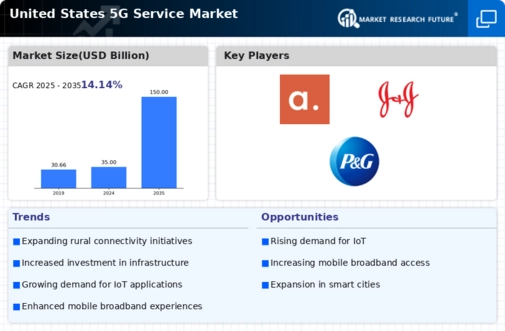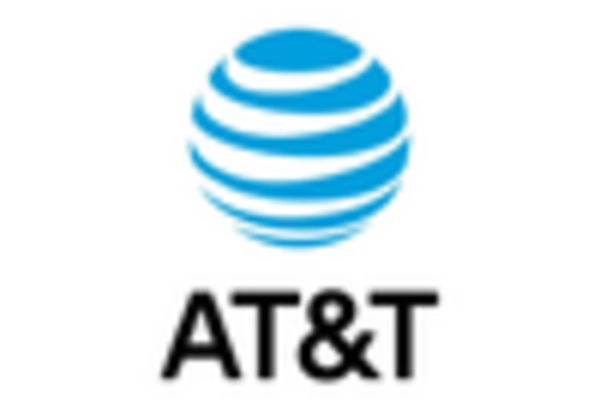Emergence of Smart Cities
The concept of smart cities is gaining traction in the US, which is expected to have a profound impact on the 5g service market. As urban areas increasingly adopt smart technologies, the demand for reliable and high-speed connectivity becomes paramount. 5g networks are essential for supporting the vast array of IoT devices and applications that contribute to the functionality of smart cities, such as traffic management systems, public safety solutions, and energy-efficient infrastructure. The integration of 5g technology into urban planning is projected to enhance operational efficiency and improve the quality of life for residents. This trend indicates a promising future for the 5g service market, as municipalities invest in the necessary infrastructure to support smart city initiatives.
Government Initiatives and Funding
Government initiatives aimed at promoting the deployment of 5g technology are playing a crucial role in the growth of the 5g service market. Federal and state governments are allocating substantial funding to enhance telecommunications infrastructure, particularly in underserved areas. For instance, the Federal Communications Commission (FCC) has introduced various programs to facilitate the rollout of 5g networks, which could potentially lead to an increase in market penetration. The investment in 5g infrastructure is projected to reach approximately $275 billion by 2025, underscoring the commitment to advancing connectivity. These initiatives not only support the expansion of the 5g service market but also aim to bridge the digital divide, ensuring equitable access to high-speed internet across diverse demographics.
Rising Demand for High-Speed Connectivity
The 5g service market is experiencing a notable surge in demand for high-speed connectivity, driven by the increasing reliance on digital services across various sectors. Businesses and consumers alike are seeking faster internet speeds to support activities such as streaming, online gaming, and remote work. According to recent data, the average download speed in the US has increased significantly, with 5g technology offering speeds up to 10 Gbps. This demand for enhanced connectivity is likely to propel the growth of the 5g service market, as service providers invest in infrastructure to meet consumer expectations. Furthermore, the proliferation of smart devices and applications that require robust internet connectivity is expected to further stimulate this market, indicating a strong trajectory for the 5g service market in the coming years.
Increased Investment in Telecommunications
The 5g service market is witnessing a significant influx of investment from telecommunications companies, which is essential for the development and expansion of 5g networks. Major players in the industry are allocating billions of dollars to enhance their infrastructure and improve service offerings. For example, it is estimated that the US telecommunications sector will invest around $130 billion in 5g technology over the next few years. This investment is likely to facilitate the deployment of advanced technologies, such as small cells and fiber optics, which are critical for delivering high-quality 5g services. As competition intensifies among service providers, the focus on innovation and customer satisfaction is expected to drive further growth in the 5g service market.
Growth of Mobile Gaming and Streaming Services
The rapid growth of mobile gaming and streaming services is significantly influencing the 5g service market. As consumers increasingly turn to mobile platforms for entertainment, the demand for high-speed internet becomes critical. 5g technology offers the low latency and high bandwidth necessary for seamless gaming experiences and high-definition streaming. Recent statistics suggest that mobile gaming revenue in the US is expected to surpass $30 billion by 2025, further emphasizing the need for robust connectivity solutions. This trend is likely to drive service providers to enhance their 5g offerings, catering to the evolving preferences of consumers. Consequently, the expansion of mobile gaming and streaming services is poised to be a key driver of growth in the 5g service market.

















Leave a Comment